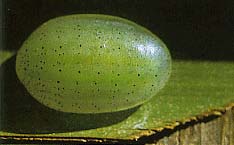|
Birthamoides
Hering
Type species: junctura Walker.
This genus in the sensu stricto consists of a series of large
dark brownish red species that replace each other from India to the Solomons.
Apart from the type species there is B. circinatus Snellen from the
Philippines and Sulawesi and a closely related trio from the Papuan subregion: buruana
West (Buru, Kei, Dammer); angustipennis Hering (New Guinea); extincta
(Bismarcks, Solomons). The forewing fasciation is similar to that of Praesetora.
Hering (1931) included further species that fall outside the generic
definition set out here.
The male antennae are bipectinate and broadly bipectinate over the basal
half and the palps are as in other members of the crescent-signum group,
directed anteriorly, deeply keeled with scales on the second segment, the third
segment small, obscured. The white area at the apex of the fore-tibia is
elongate, large, and there is also a smaller basal spot.
The male genitalia are typical of the limacodid ground plan but have
what appear to be the juxta or perhaps a centrally fused furca produced
asymmetrically into two arms. That on the left is very short, that on the right
long, whiplash-like in junctura, short, broad curved in bilineata and
intermediate, slender, sinuous in the Papuan trio.
The female genitalia have the ductus without a distinct spiral but the
bursa contains a small slightly bilobed signum of the crescentic type (angustipennis
examined).
The larva of junctura is atypical of the crescent-signum group.
Bell (MS) described it as semiovoid, somewhat parallel-sided, with flanges round
the edge. It lacks processes, tubercles or spines, being smooth and shining
resembling a lump of bluish green fat; B. circinatus larvae are very
similar (M.J.W. Cock, pers. comm., and below).

Larva of Birthamoides circinatus on coconut in the Philippines. (M.J.W.
Cock)
<<Back
>>Forward <<Return
to Contents page
|

